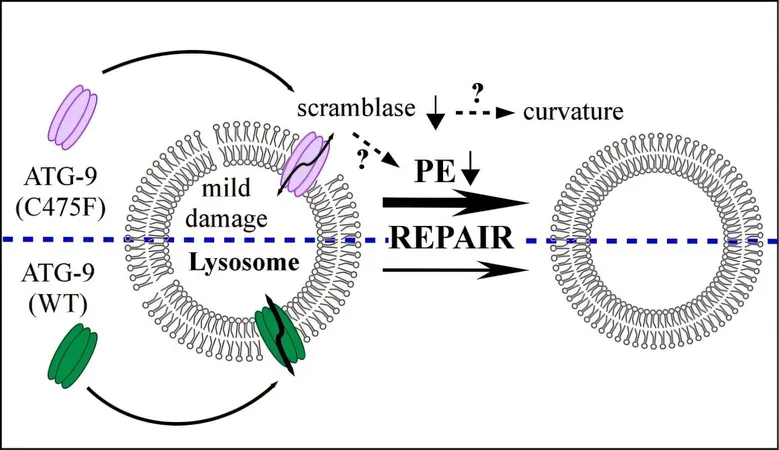
Revolutionary Discovery: How ATG-9 Protein Holds the Key to Lysosome Health!
2025-04-16
Author: Rajesh
Unlocking the Secrets of Lysosomes: The Cell's Recycling Powerhouse
Imagine a tiny waste management facility operating within every cell of your body—that's what lysosomes do! These remarkable membrane-bound organelles are responsible for breaking down waste materials, toxic compounds, and even damaged components, using their powerful digestive enzymes. They are essential for maintaining cellular health, and when they malfunction, a host of diseases like Alzheimer’s, Parkinson’s, and Huntington’s can arise.
Groundbreaking Research Reveals ATG-9's Role in Lysosome Repair
In an exciting new study published in the Journal of Cell Biology, researchers led by Prof. Zhang Hong from the Institute of Biophysics at the Chinese Academy of Sciences have unveiled a fascinating aspect of autophagy protein ATG-9. This protein plays a crucial role in repairing damaged lysosomes, potentially paving the way for innovative treatments for lysosomal diseases.
The Multi-Talented ATG-9: More Than Just an Autophagy Protein
ATG-9 is not just sitting idle; it’s active at various stages in forming autophagosomes—tiny bubbles that transport debris to lysosomes. But that's not all! This remarkable protein also acts as a phospholipid scramblase, regulating membrane lipids’ distribution and affecting membrane shape and function. Such actions are vital for expanding the autophagic isolation membrane that helps in cellular cleanup operations.
Key Findings: How ATG-9 Enhances Lysosomal Function
In their experiments with epg-5 mutant C. elegans, researchers observed that ATG-9 vesicles gathered around mildly damaged lysosomes. Strikingly, they discovered that by reducing ATG-9's scramblase activity, they could significantly enhance the repair of these lysosomes, leading to improved functionality and resolving autophagy defects.
The Lipid Connection: How Phospholipids Influence Lysosome Dynamics
The study revealed an intriguing link between lipid composition and lysosomal health: decreasing the synthesis of phosphatidylethanolamine (PE) imitated the effects of impaired ATG-9 scramblase activity. This correlation indicates that the distribution of phospholipids is crucial to maintaining lysosomal membrane dynamics, stability, and overall health.
A Step Towards New Therapies for Lysosome-Related Diseases
These groundbreaking findings suggest that manipulating ATG-9 scramblase activity could enhance lysosome biogenesis and repair, offering exciting avenues for therapeutic strategies against lysosomal diseases. Clearly, understanding and harnessing the power of autophagy proteins like ATG-9 opens up a world of possibilities for improving cellular health and combating degenerative diseases!



 Brasil (PT)
Brasil (PT)
 Canada (EN)
Canada (EN)
 Chile (ES)
Chile (ES)
 Česko (CS)
Česko (CS)
 대한민국 (KO)
대한민국 (KO)
 España (ES)
España (ES)
 France (FR)
France (FR)
 Hong Kong (EN)
Hong Kong (EN)
 Italia (IT)
Italia (IT)
 日本 (JA)
日本 (JA)
 Magyarország (HU)
Magyarország (HU)
 Norge (NO)
Norge (NO)
 Polska (PL)
Polska (PL)
 Schweiz (DE)
Schweiz (DE)
 Singapore (EN)
Singapore (EN)
 Sverige (SV)
Sverige (SV)
 Suomi (FI)
Suomi (FI)
 Türkiye (TR)
Türkiye (TR)
 الإمارات العربية المتحدة (AR)
الإمارات العربية المتحدة (AR)